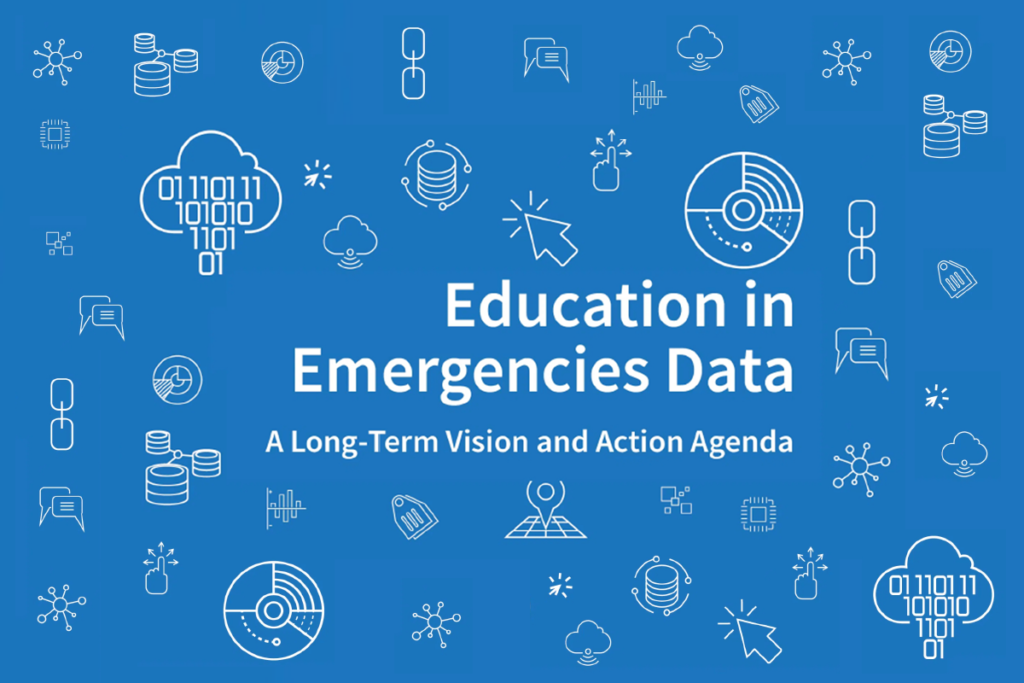This blog post by Sébastien Hine, Anne Smiley, Patrick Montjouridès and Sonja Anderson is cross-posted with NORRAG, the Inter-agency Network for Education in Emergencies (INEE) and USAID on occasion of the International Day for Universal Access to Information. It presents the newly released “Long-term vision and Action Agenda for education in emergencies data,” an outcome of the Education in Emergencies Data Summit held in Geneva on June 2019.
The formatting and spelling in this post appear as originally produced by our partners.
The education needs and priorities of children and youth in humanitarian situations are well documented. However, fulfilling their right to education is not possible without adequate information. To coincide with the International Day for Universal Access to Information on September 28th – a coalition of organizations release a long-term vision and Action Agenda for education in emergencies (EiE) data. This sets out a path to strengthen systems that collect, store, and make available education data in humanitarian settings and is based on the outcomes of the Education in Emergencies Data Summit held in Geneva in June 2019. At the 2-day meeting – organized by the INEE, NORRAG, the Swiss Agency for Development and Cooperation, and USAID – education in emergency data experts from almost 50 organisations gathered to discuss and agree ways forward on the following challenge: how – with limited resources and a growing number of crises, which are increasingly cross-border – we as a sector could firstly collect more meaningful education data in emergencies and secondly how we could also make new and existing data more accessible.
The long-term vision
In-depth discussions and expert presentations on issues such as forgotten populations, data sharing ethics, capacity building, and indicator framework harmonisation led to an agreed long-term vision with five points:
- Strong methodological and ethical foundations must underpin EiE data collection, storage, and use. The primary purpose of this data is to support the intervention of programmes and strengthening of education systems. Ideally, this data would be comparable across contexts and over time while also able to be contextualised to meet the needs of emergency-affected populations.
- Where possible, data sharing should become the norm with increased use of global repositories and platforms. Again, this must adhere to strict ethical and protection guidelines.
- Data should be made more accessible to non-data specialists for use in research, advocacy, and programme design and implementation, while organisations should simultaneously strengthen data literacy and capacity of their own staff.
- Groups currently absent or underrepresented by the statistical picture – such as IDPs, refugees, girls, speakers of minority languages and other marginalised groups – must be prioritised.
- None of this is possible without adequate funding. As funding for EiE as a sector increases so should funding for EiE data initiatives, initiatives which often help make the case for EiE itself and so increase funding for the sector.
From vision to action
Key to this event was not just generating recommendations for the sector or specific actors, but also to agree next steps to take this vision forward. These are outlined in the Action Agenda, which summarises the key discussions, general recommendations, and agreed key actions from the Summit.
The first of the Action Agenda’s key commitments is the agreement that the INEE Data and Evidence Collaborative would convene an Expert Group, the main purpose of which will be to oversee the implementation of the Action Agenda and to make reasonable steps towards the improvement of the EiE data ecosystem. Facilitated by INEE, it will also lead the development of standardised methodologies for a minimum set of EiE indicators. The Expert Group will consist of key EiE data experts from a range of organisations that have EiE mandates.
Greater availability of data – especially on marginalised groups – will not only strengthen the work of practitioners, researchers, advocates and the international community but critically it should enhance the ability of national systems to respond to crises as they emerge. Much of the work needed to make this possible is already occurring, although often in isolation with limited uptake of encouraging initiatives. Crucially, what the Action Agenda does, is convene stakeholders to take forward a coherent plan that enhances collaboration between actors and avoid duplication of efforts.
Further resources
The Action Agenda can be found here.
The full Minutes from the meeting can be found here.
The session recordings can be found here.
The presentations can be found here.
Video presentation
About the authors
Sébastien Hine is an education and international development consultant who has previously worked on education in emergencies for the UNESCO’s Global Education Monitoring Report, Save the Children, and the Overseas Development Institute.
Anne Smiley, EdD, is Associate Director of Research and Evaluation at FHI 360 and leads the EiE data component of the USAID Middle East Education Research, Training and Support (MEERS) program, which is implemented by Social Impact and FHI 360.
Patrick Montjouridès is Senior Research Associate at NORRAG and a PhD candidate at the University of Cambridge. He previously worked as Education Program Specialist at the UNESCO Institute of Statistics, Research Officer at UNESCO’s Global Education Monitoring Report and at the Institute for Research in the Sociology and Economics of Education (IREDU) of the University of Burgundy from which he holds an M.A. in Economics Education.
Sonja Anderson is the Evidence Coordinator at INEE where she manages various evidence initiatives including the E-Cubed Research Fund and the process to designate an INEE Learning Agenda. Sonja holds an M.Ed. from HGSE in International Education Policy.

